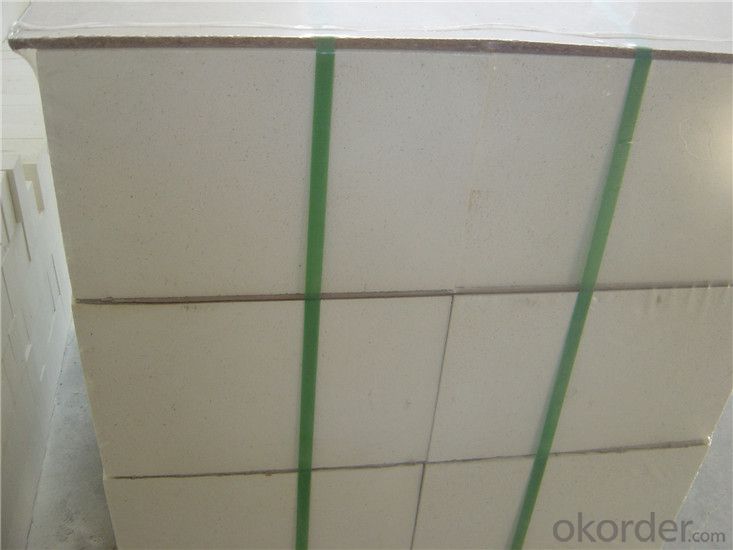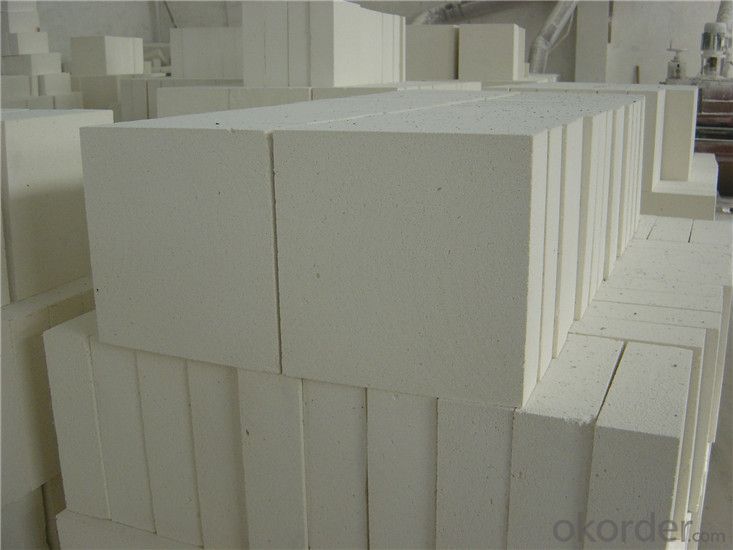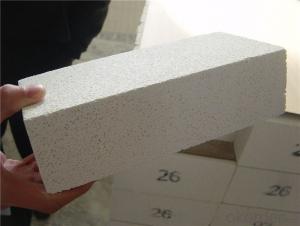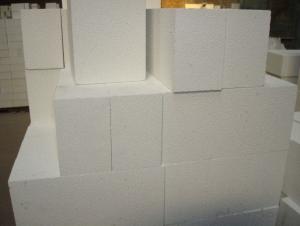Insulating Brick Insulation Brick Mullite Brick
- Loading Port:
- Shanghai
- Payment Terms:
- TT OR LC
- Min Order Qty:
- 1 m.t.
- Supply Capability:
- 1000 m.t./month
OKorder Service Pledge
OKorder Financial Service
You Might Also Like
CNBM conforms strictly to the requirements of ISO 9000 quality control system during the production. MSDS is also available if you want. The thermal insulation fire clay brick meet with the requirements of ASTM & JIS standards. So please stay cool with our quality.
Application
Insulating Fire Brick are used for the lining of converter, alternating current arc furnace, direct Current arc furnace and the ladle slag line, etc.
Insulating Fire Brick Technical index
Brand Quality | JM23 | JM26 | JM28 | JM30 | JM32 | |
Bulk Density (g/cm3) | 0.52 | 0.78 | 0.88 | 1.03 | 1.25 | |
1.2 | 1.6 | 2.1 | 2.5 | 3.5 | ||
Modulus of Rupture (Mpa) | 0.9 | 1.4 | 1.6 | 2.1 | 2.1 | |
-0.5 | 1400℃ -0.4 | 1510℃ -0.5 | 1620℃ -0.9 | 1730℃ -0.9 | ||
Thermal Expansion 1100℃(%) |
0.5 |
0.7 |
0.8 |
0.9 |
1.1 | |
Thermal conductivity(W/m.k)
| 400℃ | 0.14 | 0.27 | 0.32 | 0.41 | 0.49 |
600℃ | 0.16 | 0.29 | 0.34 | 0.43 | 0.50 | |
800℃ | 0.18 | 0.31 | 0.36 | 0.44 | 0.51 | |
1000℃ | 0.20 | 0.33 | 0.38 | 0.45 | 0.53 | |
Al2O3 | 37 | 58 | 67 | 73 | 77 | |
Fe2O3 | 0.7 | 0.7 | 0.6 | 0.5 | 0.4 | |
Equipment
1 unit of Ceramic Abrasive (SG Abrasive) pilot production line
2 units of Compact grain Abrasive pilot production lines
1 unit of high-end coated abrasives (abrasive cloth) production line
2 units of Boron Carbide production lines
3 large flexible crushing and sieving lines for grit production lines
2 units of 2000KVA furnaces for Boron Carbide fusion
6 units of 5000KVA-10000KVA dumping type electric arc furnaces for Brown Fused Alumina fusion
Company Advantage
(1)Long Insulating Fire Brick manufacture history: 25 years manufacturer
(2)Advanced equipment
(3)Diversification of production standards: ISO ANSI FEPA JIS ASTM
(4)Flexible payment: T/T L/C D/P D/A
(5)Professional marketing team and after-sale service
(6)Free sample


- Q:Do insulating fire bricks emit any harmful gases when heated?
- No, insulating fire bricks do not emit any harmful gases when heated. They are specifically designed to have excellent thermal insulation properties without releasing any harmful emissions.
- Q:Do insulating fire bricks have a low density?
- Yes, insulating fire bricks typically have a low density compared to other types of bricks.
- Q:What is the typical creep resistance of an insulating fire brick?
- The typical creep resistance of an insulating fire brick is high, as it is designed to withstand high temperatures without deforming or sagging over time.
- Q:Can insulating fire bricks be used for insulation in power plants?
- Yes, insulating fire bricks can be used for insulation in power plants. Insulating fire bricks are designed to have excellent thermal insulation properties, which make them suitable for high-temperature applications. They can withstand extreme temperatures and provide effective insulation to prevent heat loss and increase energy efficiency in power plant operations. The insulating fire bricks are often used in various areas of power plants, such as furnaces, boilers, kilns, and chimneys. They can be used to line the walls, floors, and roofs of these structures to reduce heat transfer and maintain the desired temperatures inside the equipment. In power plants, insulating fire bricks help to minimize heat loss, improve combustion efficiency, and reduce thermal stress on the equipment. By providing a barrier against heat transfer, they help in conserving energy and reducing operational costs. Additionally, the insulation properties of these bricks also contribute to a safer working environment for power plant personnel. It's worth noting that while insulating fire bricks are suitable for insulation in power plants, they should be selected carefully based on the specific requirements and conditions of the power plant. Factors such as the operating temperature, chemical exposure, and mechanical stress should be considered to ensure the bricks can withstand the harsh conditions and provide long-lasting insulation performance.
- Q:Are insulating fire bricks resistant to molten salts?
- Insulating fire bricks are known for their general resistance to molten salts. These bricks are specifically designed to endure high temperatures and provide excellent thermal insulation. They are typically crafted from special refractory materials with a high melting point and chemical inertness. In contrast, molten salts have a corrosive nature that can cause harm to various materials. Nevertheless, insulating fire bricks can endure the corrosive effects of molten salts due to their distinctive composition. Their dense structure and superior refractory properties enable them to resist the corrosive impact of molten salts over extended periods. Moreover, insulating fire bricks find widespread use in industries like metal smelting, glass manufacturing, and chemical processing, where encounters with molten salts are common. Their resistance to molten salts makes them highly suitable for applications involving these corrosive substances. However, it is important to note that the specific resistance of insulating fire bricks to molten salts can vary depending on the brick's composition and the type of molten salt used. Therefore, it is recommended to consult the manufacturer or a refractory materials specialist to ensure the appropriateness of insulating fire bricks for a particular application involving molten salts.
- Q:What's the difference between refractory bricks and insulating bricks?
- In the preferred insulation performance, the thermal conductivity of insulating brick insulation brick in general 0.2-0.4 (average temperature 350 - 25 DEG C) w/m.k, and the thermal conductivity of refractory brick in 1 (the average temperature of 350 - 25 DEG C) above w/m.k, which can obtain the insulation performance of insulating brick than refractory brick insulation performance is much better. In the degree of refractoriness, the refractoriness of insulating bricks is generally below 1400 degrees, while the refractoriness of refractory bricks is above 1400 degrees. In density, insulation bricks are generally lightweight insulation materials, the density is generally in 0.8-1.0g/cm3, and the density of refractory bricks are basically above 2.0g/cm3.
- Q:Can insulating fire bricks be used to line industrial boilers?
- Yes, insulating fire bricks can be used to line industrial boilers. Insulating fire bricks are specially designed to have low thermal conductivity, which helps to minimize heat loss and improve energy efficiency in the boiler system. These bricks are made from lightweight materials such as clay and alumina, which have excellent insulation properties. By lining the interior of the boiler with insulating fire bricks, the heat generated by the combustion process can be contained within the boiler, resulting in higher heating efficiency and reduced fuel consumption. Additionally, insulating fire bricks can withstand high temperatures and thermal shocks, making them suitable for the harsh operating conditions often encountered in industrial boilers. Overall, using insulating fire bricks as a lining material in industrial boilers can contribute to improved energy efficiency, reduced operating costs, and increased durability of the boiler system.
- Q:Can insulating fire bricks be used in glass furnaces?
- Glass furnaces can indeed utilize insulating fire bricks. These bricks are specifically engineered with low thermal conductivity, rendering them ideal for high-temperature environments such as glass furnaces. The implementation of these bricks aids in the reduction of heat loss from the furnace, consequently enhancing energy efficiency and decreasing operational expenses. Moreover, they offer superior insulation and aid in maintaining consistent temperatures within the furnace, a vital factor in glass production. Furthermore, insulating fire bricks exhibit excellent resistance to thermal shock and can endure the extreme temperatures and rapid temperature fluctuations that are common in glass furnaces. Overall, integrating insulating fire bricks into glass furnaces can result in enhanced furnace performance, heightened productivity, and energy conservation.
- Q:Can insulating fire bricks be recycled or reused?
- Yes, insulating fire bricks can be recycled or reused. They can be crushed down and used as fillers in various construction materials or as a base material for roads. Additionally, they can be reclaimed and reused in various industrial processes that require heat insulation.
- Q:Are insulating fire bricks suitable for insulation in refinery heaters?
- Yes, insulating fire bricks are suitable for insulation in refinery heaters. Refinery heaters operate at extremely high temperatures, and insulating fire bricks are designed to withstand these temperatures and provide effective insulation. These bricks have low thermal conductivity, which means they can prevent heat from escaping the heater, thus reducing energy loss and increasing the overall efficiency of the heater. Additionally, insulating fire bricks have excellent thermal shock resistance, meaning they can withstand rapid temperature changes without cracking or breaking. This is crucial in refinery heaters, as they often experience frequent temperature fluctuations during operation. Furthermore, insulating fire bricks are lightweight and easy to install, making them a convenient choice for insulation in refinery heaters. Overall, insulating fire bricks are a suitable and effective option for insulation in refinery heaters.
1. Manufacturer Overview |
|
|---|---|
| Location | |
| Year Established | |
| Annual Output Value | |
| Main Markets | |
| Company Certifications | |
2. Manufacturer Certificates |
|
|---|---|
| a) Certification Name | |
| Range | |
| Reference | |
| Validity Period | |
3. Manufacturer Capability |
|
|---|---|
| a)Trade Capacity | |
| Nearest Port | |
| Export Percentage | |
| No.of Employees in Trade Department | |
| Language Spoken: | |
| b)Factory Information | |
| Factory Size: | |
| No. of Production Lines | |
| Contract Manufacturing | |
| Product Price Range | |
Send your message to us
Insulating Brick Insulation Brick Mullite Brick
- Loading Port:
- Shanghai
- Payment Terms:
- TT OR LC
- Min Order Qty:
- 1 m.t.
- Supply Capability:
- 1000 m.t./month
OKorder Service Pledge
OKorder Financial Service
Similar products
New products
Hot products
Related keywords



























